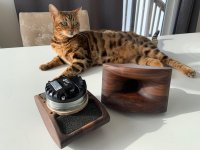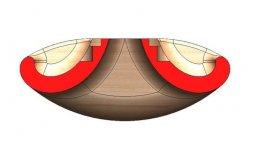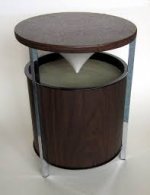Howdy folks. Forgive me if this is an absurd line of reasoning, but I have a question regarding the manner in which sound travels in a horn / waveguide speaker. I have been watching a bunch of YouTube videos from Joseph Crowe, as well as reading some of his blog posts, and I have noticed that he pays a great deal of attention to how the sound travels along the horn even after it wraps around to the other side of it. This is obvious just by looking at his designs, which I have attached. At this time I do not understand the math involved with the shapes he comes up with, but I do know the shape of the back of the horn is just a continuation of the formula that dictates the shape of the front of the horn, which if followed further seems to start to spiral?
Mr. Crowe seems interested in minimizing diffraction, as well as deadening the sound that makes it to the backside of the horn (back waves?). In the picture featuring his cat you can see that he has put acoustic dampening into the concavity in the back of the horn, which is meant to attenuate the sound energy.
Mr. Crowe seems to think this rear radiation is substantial enough to warrant this sort of design, and I am wondering if you could take this in a different direction.
If you had the mathematical know how, could you hypothetically guide this backward travelling sound energy into a shape that disperses the sound in a manner that mimics the sound of a dipole or bipole speaker? I know the time alignment would be different, but just considering the listener's perception, I am wondering if something pleasing to the ear could be achieved. Sort of an "ambient tweeter" effect, like in the Smell E/III
I am new to audio, and very ignorant to the math behind speaker design, so forgive me if this is an obviously dumb idea. Thank you!
Mr. Crowe seems interested in minimizing diffraction, as well as deadening the sound that makes it to the backside of the horn (back waves?). In the picture featuring his cat you can see that he has put acoustic dampening into the concavity in the back of the horn, which is meant to attenuate the sound energy.
Mr. Crowe seems to think this rear radiation is substantial enough to warrant this sort of design, and I am wondering if you could take this in a different direction.
If you had the mathematical know how, could you hypothetically guide this backward travelling sound energy into a shape that disperses the sound in a manner that mimics the sound of a dipole or bipole speaker? I know the time alignment would be different, but just considering the listener's perception, I am wondering if something pleasing to the ear could be achieved. Sort of an "ambient tweeter" effect, like in the Smell E/III
I am new to audio, and very ignorant to the math behind speaker design, so forgive me if this is an obviously dumb idea. Thank you!
Attachments
Last edited:
It strikes me as possibly kind of defeating the purpose of waveguiding a tweeter to also try to amplify its backward firing energy, but as someone with little experience, I guess I am just curious as to what that would sound like
If this is possible, I don't really have any idea what it would look like, but what I kind of had in mind was one of those cone things in those old crappy zenith speakers. Having it attached to the back of the horn and maybe have it attached to a short adjustable rod to to fit it to your room or something. Or would it becoming poky like the B&W Nautilus work better? None of the above? Is my cluelessness showing? Lol.
Attachments
Last edited:
Hi Bryguy,
well observed. See ATH thread https://www.diyaudio.com/community/...he-easy-way-ath4.338806/page-172#post-6364005
It has been possible to make such device without any diffraction effects seen in response for few years now. Its because of the mouth rollback / mouth termination, as Joseph Crowe does it as well. Although slightly better performance seems to come without "backfill" difference is not big, as long as there is some kind of rollback performance is better than none at all. I don't know how audible the difference is.
Most commercial devices (PA horns / waveguides) do not have proper mouth termination, but one could retrofit one. Some freestanding horns for Hifi market seem to have them. Perhaps looks or utility is more important than diffraction for someone. Well, its all fine as you can make tailor fit device for your application with the ATH script in no time 🙂
well observed. See ATH thread https://www.diyaudio.com/community/...he-easy-way-ath4.338806/page-172#post-6364005
It has been possible to make such device without any diffraction effects seen in response for few years now. Its because of the mouth rollback / mouth termination, as Joseph Crowe does it as well. Although slightly better performance seems to come without "backfill" difference is not big, as long as there is some kind of rollback performance is better than none at all. I don't know how audible the difference is.
Most commercial devices (PA horns / waveguides) do not have proper mouth termination, but one could retrofit one. Some freestanding horns for Hifi market seem to have them. Perhaps looks or utility is more important than diffraction for someone. Well, its all fine as you can make tailor fit device for your application with the ATH script in no time 🙂
Last edited:
You seem to be forgetting your history, tmuikku. Such devices have been known for a very long time, devices which continue to diffract all the way around the back, and where you don't easily see the effects in the response. Take for example the LeCleach horn.It has been possible to make such device without any diffraction effects seen in response for few years now.
Sorry wrong wording, you are right and that is exactly what I ment, there are some that have good mouth termination and mentioned it. I ment that now anybody can make one, change features of a device easily and see what it does to response in BEM simulation. The whole process is so easy multiple variations can be checked out in an hour with home computer without much any knowledge what one is doing. Any size and shape can be optimized in this regard just by adding roundover.
You sacrifice directivity to improve other things. Everything has a limit.. you have to know where to draw the line.
Bryguy, what gets you interested in a waveguide?
Bryguy, what gets you interested in a waveguide?
Without knowing what you mean exactly its usually the case, optimizing for something means trading off something else. There is case where its hard to make "constant directivity" with ATH and leaving some of the mouth diffraction happening has kind of effect to make more constant directivity on the graphs but it looks like diffraction side effect to my eye and not sure if it is good or bad thing. Overall hard to say what the audible difference would be if any. This weekend will be exciting, I have some ST260 devices waiting to be collected to replace RCF H100 🙂 They are not exactly alike and two greatest differences are mouth rollback and hopefully top octave performance. Will post measurements in ATH thread.
You seem to be forgetting your history, tmuikku. Such devices have been known for a very long time, devices which continue to diffract all the way around the back, and where you don't easily see the effects in the response. Take for example the LeCleach horn.
I wonder who first clearly drew attention to the horn edge diffraction problem and proposed "roll-back" design
 . As far as I remember, roll-back Kugelwellenhorn/Spherical wavefront horn was invented long before Le Cleach roll-back design, but I don't know if it was indicated that this design would reduce edge diffraction distortion. Jean-Michel Le Cleach clearly stated that the roll-back design reduces diffraction.
. As far as I remember, roll-back Kugelwellenhorn/Spherical wavefront horn was invented long before Le Cleach roll-back design, but I don't know if it was indicated that this design would reduce edge diffraction distortion. Jean-Michel Le Cleach clearly stated that the roll-back design reduces diffraction.If I'm not mistaken, I've heard the LeCleach described as an exponential horn designed for spherical waves, in the sense that a regular exponential is made assuming planar waves and doesn't work as consistently as expected. I've read similar sounding about the Kugelwellen.
Jean-Michel also talked about constant expansion. Now, any expansion can encourage the wavefront into that space (diffract), the LeCleach tends to diffract in a consistent way along the walls. This is one of the qualities that makes it useful as a termination.
Jean-Michel also talked about constant expansion. Now, any expansion can encourage the wavefront into that space (diffract), the LeCleach tends to diffract in a consistent way along the walls. This is one of the qualities that makes it useful as a termination.
What does it even mean? What I found is that any profile with smoothly changing wall curvature behaves virtually the same. Some of those profiles may have "names" but that doesn't mean anything.Now, any expansion can encourage the wavefront into that space (diffract), the LeCleach tends to diffract in a consistent way along the walls.
It seems that guys from Kenwood corporation (Hayakawa Junichi, Iwakura Shiro, Yamazaki Kaoru, Matsuoka, Susumu) were first who indicated roll-back design is capable to reduce diffraction distortion
https://www.aes.org/e-lib/browse.cfm?elib=5138
Improvement in Dome Loudspeaker Characteristics by Using a Spherical-Wave-Front Horn Baffle
A new baffle shape can be used to improve dome loudspeaker performance significantly. Conventionally a dome loudspeaker is mounted on a flat baffle such that the sound waves radiating from the diaphragm are subject to reflection, interference, and diffraction, which results in irregular response characteristics. Noting that the wave front of a dome-shaped diaphragm is nearly spherical, we decided to use a horn to spread the wave front without distorting it. With this baffle it is theoretically possible to obtain the equivalent of a pulsating sphere at the opening. In theory there would be no problems of reflection, interference, or diffraction. Using an experiment baffle, we were able to confirm our hypothesis. We were also able to make further improvements in directional and imaging characteristics. Applying this new baffle toa dome loudspeaker, we found that it did indeed alleviate common problems and provide an optimum environment for dome loudspeaker operation.
https://www.aes.org/e-lib/browse.cfm?elib=5138
Improvement in Dome Loudspeaker Characteristics by Using a Spherical-Wave-Front Horn Baffle
A new baffle shape can be used to improve dome loudspeaker performance significantly. Conventionally a dome loudspeaker is mounted on a flat baffle such that the sound waves radiating from the diaphragm are subject to reflection, interference, and diffraction, which results in irregular response characteristics. Noting that the wave front of a dome-shaped diaphragm is nearly spherical, we decided to use a horn to spread the wave front without distorting it. With this baffle it is theoretically possible to obtain the equivalent of a pulsating sphere at the opening. In theory there would be no problems of reflection, interference, or diffraction. Using an experiment baffle, we were able to confirm our hypothesis. We were also able to make further improvements in directional and imaging characteristics. Applying this new baffle toa dome loudspeaker, we found that it did indeed alleviate common problems and provide an optimum environment for dome loudspeaker operation.
Adding a shallow waveguide to a conventional dome tweeter is more about reflecting the sound that normally radiated by the dome to the sides, back towards the center. This makes it more directional and more sensitive on-axis.
What is shown in the 1st post is compression driver with a horn. This shares little in common with a conventional dome and 'waveguide', other than externally looking similar.
It's impossible to eliminate sound radiating to the sides (like a dipole) using only a horn or waveguide, as at some (low) frequency the horn becomes too small to do anything to the wavefront and it simply diffracts around to the sides unattenuated. The speaker radiates as omni-directional.
Adding some damping material to the sides or rear of the speaker enclosure/horn will seldom do much if at all, since physics dictates that the thickness of the damping material would have to be greater than the width of the speaker enclosure/horn to be at all effective at the frequencies where sound diffracts around. Adding a thin foam to the back of a horn will do essentially nothing.
What is shown in the 1st post is compression driver with a horn. This shares little in common with a conventional dome and 'waveguide', other than externally looking similar.
It's impossible to eliminate sound radiating to the sides (like a dipole) using only a horn or waveguide, as at some (low) frequency the horn becomes too small to do anything to the wavefront and it simply diffracts around to the sides unattenuated. The speaker radiates as omni-directional.
Adding some damping material to the sides or rear of the speaker enclosure/horn will seldom do much if at all, since physics dictates that the thickness of the damping material would have to be greater than the width of the speaker enclosure/horn to be at all effective at the frequencies where sound diffracts around. Adding a thin foam to the back of a horn will do essentially nothing.
Last edited:
No, I don't think what you say and that's not what I meant.mabat, from past experience you hear the word diffraction and you automatically think it is bad. No one is saying that. You can't see around a corner so it will have to diffract.. the roundover brings order to that diffraction.
What does it mean to "diffract in a consistent way"? What's so special about a LeCleach profile in this regard?
One simply doesn't want any abrupt changes in curvature near the mouth. It's as simple as that.
Adding a shallow waveguide to a conventional dome tweeter is more about reflecting the sound that normally radiated by the dome to the sides, back towards the center. This makes it more directional and more sensitive on-axis.
What is shown in the 1st post is compression driver with a horn. This shares little in common with a conventional dome and 'waveguide', other than externally looking similar.
From a point of view of physics, it does not matter at all what type of source we use, the problem of reflection / diffraction of sound is associated with a sharp change in the environment acoustic impedance and/or with a abrupt change in the baffle/horn curvature.
- Home
- Loudspeakers
- Multi-Way
- Horn/Waveguide Dispersion Question


